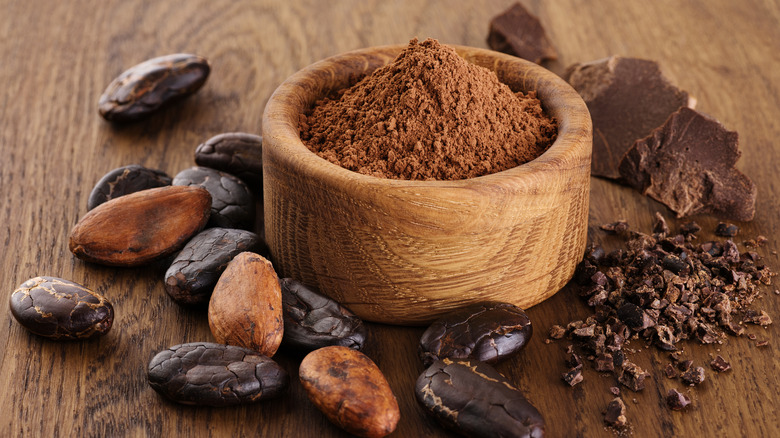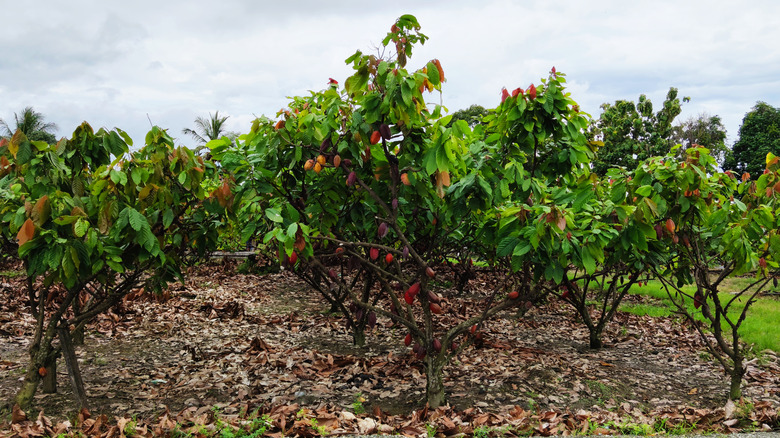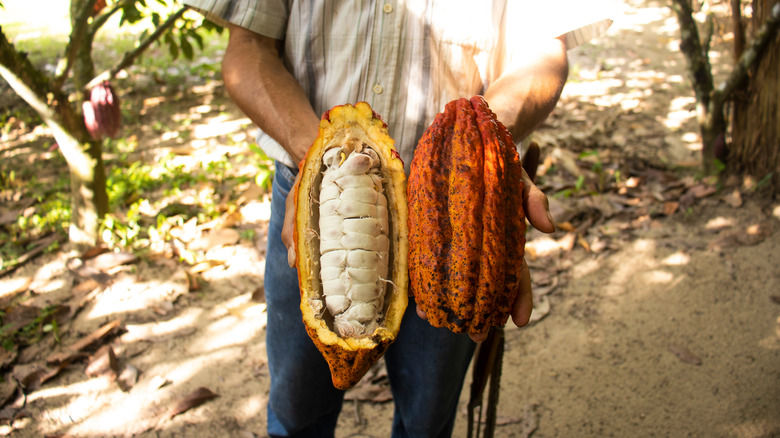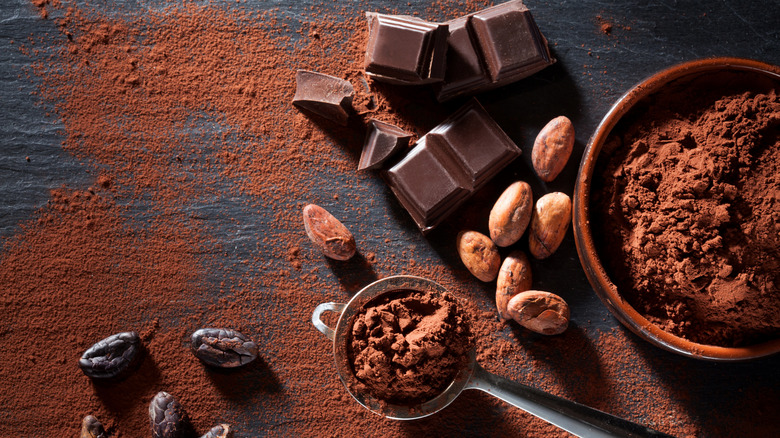Most Of The World's Cocoa Comes From This Country
While chocolate is usually what comes to mind when hearing the word cocoa, the cocoa bean is simply a seed of the cacao tree, per Britannica. The cacao tree is officially named Theobroma Cacao, which is the Greek term for "food of the gods" — it's safe to say no chocolate lover would argue with that (via chocolate.org).
Chocolate is made from the cacao seed that has been processed into a paste (or liquor), and then into cocoa powder or a chocolate bar, among other variations. The seed grows inside a pod that has a hard shell and is commonly a shade of either red, yellow, or orange. The pods take close to half a year to mature, and then are cut down from their tree with a sharp machete. Each pod holds about 50 beans — for reference, several hundred beans are required to make just one pound of chocolate.
Cacoa in all of its forms has been around for a while. Records suggest that human consumption dates back as long as 5,000 years ago.
The Ivory Coast and cocoa
Cote d'Ivoire in Western Africa produces over two million tons of cocoa every year, according to World Atlas. Since close to five million tons of cocoa are produced across the globe annually, per the Swiss Platform for Sustainable Cocoa, the country is responsible for roughly 40 percent of all the cocoa beans produced on the planet.
The continent of Africa is responsible for 81 percent of cocoa bean production, with Ghana trailing behind Cote d'Ivoire at 20 percent of the world's cocoa bean production.
When it comes to processing the beans, the crown goes to Europe. One-third of the annual cocoa bean production is ground in Europe to be made into cocoa butter, powder, chocolate, and other variations. Switzerland takes the cake for consumption, with each person consuming 11.6 kilograms on average — that's about 25 pounds per person on an annual basis.
Cote d'Ivoire's economy is contingent upon the price of cocoa and its revenue from exportation. In fact, cocoa makes up around 15 percent of the gross domestic product. Therefore, if the price of cocoa falls, the economy is in danger (via africanews).
Cocoa's roots
Cacao has its roots in Mesoamerica. The trees grow in the rainforest, typically within 20 degrees of the equator, and may live over 200 years. The Mayans and Aztecs are credited with being the first to plant and farm cocoa, per Michigan State University.
Cacao beans were extremely valuable to the ancient Aztecs and Mayans, and they would even sacrifice human lives to ensure a good harvest. They used the beans as offerings to the gods, currency, and even paid their taxes with them. Just three beans would buy you an avocado back in the day.
When the Spanish arrived in the new world, they added sugar and other flavors to the bitter cocoa (via World Cocoa Foundation). The resulting chocolate they created in a drink form became popular. So popular, in fact, they hid their coveted hot chocolate recipe from other Europeans for close to a century. Once the secret was out, however, it spread across France and England as a treat touted for its aphrodisiac properties amongst the elite.
The Industrial Revolution transformed chocolate from an indulgence for the wealthy to an affordable goody for all. Today, it is enjoyed around the globe in a myriad of beloved forms, from drinks to bars to silver-wrapped kisses.
Health benefits of cocoa
Chocolate confections and health usually don't go hand-in-hand, but the mighty cacao bean is chock full of health benefits, per WebMD. Cacao is the raw, unprocessed version of cocoa and contains more bang for the nutrient buck than cocoa. But sticking to chocolate products that are minimally processed and/or have a high cocoa content will probably provide some nutrient density.
Chocolate with a high cocoa content is a powerful source of antioxidants, according to Healthline. Dark chocolate containing a cocoa content of 70-85% is an excellent source of copper, manganese, magnesium, and iron, and a solid source of fiber. The higher the cocoa content, the lower the amount of sugar in the product, but dark chocolate is often still high in sugar and calories, so it's best to consume it only in moderation.
A study published in 2014 in Food Science & Nutrition concluded that certain types of dark chocolate can decrease cholesterol levels, including "bad" cholesterol, and triglycerides. The flavanols found in cocoa have also been linked to improved cognitive function and insulin sensitivity among elderly individuals, per a study published in Hypertension in 2012, as well as aiding in lowering blood pressure.
With all of this in mind, it's safe to say that the cacao bean, and certain products made from it, are a pretty powerful superfood. Choosing high-quality, high cocoa content sources — and enjoying them in moderation — is an excellent way to have our (chocolate) cake and eat it too.



